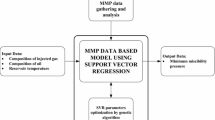The most common methods of predicting a gas/water two-phase relative permeability include experimental measurement, theoretical simulation, and numerical calculation. The experimental method is relatively accurate but time-consuming and laborious. The method of theoretical modeling involves a complicated solving process, and the range of application of the numerical calculation method is comparatively narrow. In this work, based on the least square support vector machine (LSSVM) combined with the gray optimization algorithm (GWO), the prediction model (GWO-LSSVM) of the gas/water phase permeability is established. The model was validated by the gas-water two-phase relative permeability data obtained by a non-steady-state method from a gas reservoir under high pressure/high temperature (133–152.5°C, 50.3–55 MPa) conditions. The irreducible water saturation (Swc ), absolute permeability (K), porosity (j), and gas saturation (Sg ) have been set as the input parameters. The water phase relative permeability (Krw) and the gas phase relative permeability (Krg) have been set as output variables. The training data of water phase and gas phase relative permeability were 147 and 141, respectively. The prediction data were 32 and 58, respectively. The results show that the absolute relative deviation (AARD) of Krw for the presented GWO-LSSVM model is 3.69%, while that of Krg is 2.92%, showing that the model can accurately predict the gas-water relative permeability at high temperature and high pressure. The method provides a new and effective instrument for estimating the gaswater two-phase relative permeability parameters in the development of gas reservoirs.







Similar content being viewed by others
References
National standard for oil and gas industry, “Method for measuring two-phase relative permeability in rock,” SY/T 5345-2007 China National Petroleum Company, Petroleum Industry Press, Beijing (2008).
J. R. Counsil and J. H. J. Ramey, “Effects of vaporization and temperature in gas/liquid relative permeability experiments,” Soc. Pet. Eng. J., 22(1), 108-116 (1982).
Z. Li and B. Zhao, “Using capillary pressure curve calculation method of gas-water two-phase relative permeability curve and the application,” J. Drill. Technol., 1, 46-51 (1991).
G. Lei, P. Dong, et al., “Gas-water relative permeability of tight sandstone gas reservoirs,” J. Centr. South Univ. (Sci. Technol.), 47(8), 2071-2075 (2016).
H. Daigle, “Relative permeability to water or gas in the presence of hydrates in porous media from critical path analysis,” J. Pet. Sci. Eng., 146, 526-535 (2016).
M. Yaralidarani and H. Shahverdi, “An improved Ant Colony Optimization (ACO) technique for estimation of flow functions (kr and Pc) from core-flood experiments,” J. Nat. Gas Sci. Eng., 33, 624-633 (2016).
X. Q. Bian, B. Han, Z. M. Du, et al., “Integrating support vector regression with genetic algorithm for CO2-oil minimum miscibility pressure (MMP) in pure and impure CO2 streams,” Fuel, 182, 550-557 (2016).
X. Q. Bian, K. Han, Z. Du, “Prediction of hydrate formation condition of sour natural gases by using support vector machine (SVM),” Chin. Sci., 11(9), 1017-1020 (2016).
B. H. Boyle, Support Vector Machines: Data Analysis, Machine Learning, and Applications, Nova Science Publishers, Inc., New York (2012).
D. Çalisir and E. Dogantekin, “A new intelligent hepatitis diagnosis system: PCA-LSSVM,” Expert Syst. Appl., 38, 10705-10708 (2011).
V. N. Vapnik, The Nature of Statistical Learning Theory, Springer, New York (1995).
V. Vapnik, The Nature of Statistical Learning Theory, Springer Science & Business Media, New York (2000).
A. Hemmati-Sarapardeh, R. Alipour-Yeganeh-Marand, A. Naseri, et al., “Asphaltene precipitation due to natural depletion of reservoir: determination using a SARA fraction based intelligent model,” Fluid Phase Equil., 354, 177-184 (2013).
D. Çalisir and E. Dogantekin, “A new intelligent hepatitis diagnosis system: PCA-LSSVM,” Expert Syst. Appl., 38, 10705-10708 (2011).
S. Mirjalili, S. M. Mirjalili, and A. Lewis, “Grey Wolf Optimizer,” Adv. Eng. Software, 69(3), 46–61 (2014).
S. Mirjalili, “How effective is the Grey Wolf optimizer in training multi-layer perceptrons?,” Appl. Intell., 43(1), 150-161 (2015).
X. Chen, A. Kianinejad, and D. A. DiCarlo, “Measurements of CO2-brine relative permeability in Berea sandstone using pressure taps and a long core,” Greenhouse Gas.: Sci. Technol., 7(2), 370-382 (2017).
J. Fang, P. Guo, X. Xiao, et al., “Gas-water relative permeability measurement of high temperature and high pressure tight gas reservoirs,” Pet. Explor. Dev., 42(1), 84-87 (2015).
Author information
Authors and Affiliations
Corresponding author
Additional information
Translated from Khimiya i Tekhnologiya Topliv i Masel, No. 3, pp. 105–110, May–June, 2021.
Rights and permissions
About this article
Cite this article
Wang, HF., Li, XP., Zhu, SB. et al. Prediction of Gas/Water Relative Permeability Using the GWO-LSSVM Model Under HTHP Condition. Chem Technol Fuels Oils 57, 582–590 (2021). https://doi.org/10.1007/s10553-021-01280-5
Published:
Issue Date:
DOI: https://doi.org/10.1007/s10553-021-01280-5




